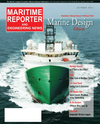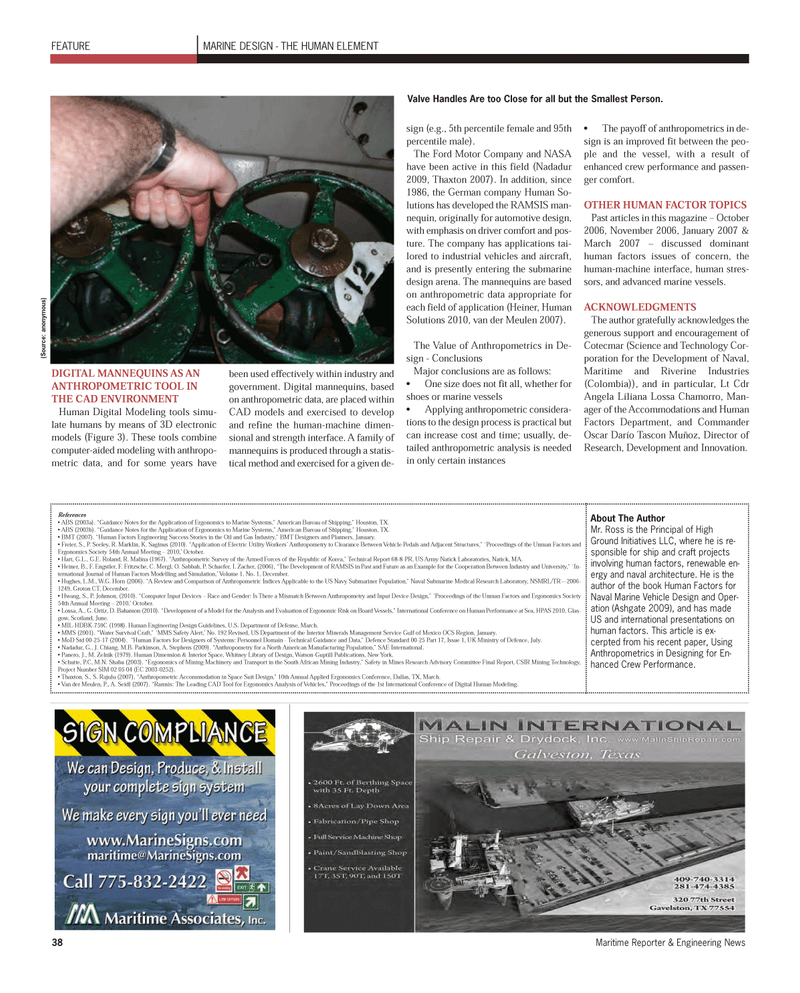
Page 38: of Maritime Reporter Magazine (October 2011)
Marine Design Annual
Read this page in Pdf, Flash or Html5 edition of October 2011 Maritime Reporter Magazine
38Maritime Reporter & Engineering News DIGITAL MANNEQUINS AS AN ANTHROPOMETRIC TOOL IN THE CAD ENVIRONMENT Human Digital Modeling tools simu-late humans by means of 3D electronicmodels (Figure 3). These tools combinecomputer-aided modeling with anthropo- metric data, and for some years have been used effectively within industry and government. Digital mannequins, based on anthropometric data, are placed withinCAD models and exercised to develop and refine the human-machine dimen- sional and strength interface. A family of mannequins is produced through a statis-tical method and exercised for a given de- sign (e.g., 5th percentile female and 95thpercentile male).The Ford Motor Company and NASA have been active in this field (Nadadur 2009, Thaxton 2007). In addition, since 1986, the German company Human So- lutions has developed the RAMSIS man- nequin, originally for automotive design, with emphasis on driver comfort and pos- ture. The company has applications tai- lored to industrial vehicles and aircraft, and is presently entering the submarinedesign arena. The mannequins are based on anthropometric data appropriate foreach field of application (Heiner, Human Solutions 2010, van der Meulen 2007). The Value of Anthropometrics in De- sign - ConclusionsMajor conclusions are as follows: One size does not fit all, whether for shoes or marine vessels Applying anthropometric considera- tions to the design process is practical but can increase cost and time; usually, de- tailed anthropometric analysis is neededin only certain instancesThe payoff of anthropometrics in de- sign is an improved fit between the peo- ple and the vessel, with a result of enhanced crew performance and passen- ger comfort.OTHER HUMAN FACTOR TOPICS Past articles in this magazine ? October 2006, November 2006, January 2007 & March 2007 ? discussed dominanthuman factors issues of concern, the human-machine interface, human stres- sors, and advanced marine vessels. ACKNOWLEDGMENTS The author gratefully acknowledges the generous support and encouragement ofCotecmar (Science and Technology Cor- poration for the Development of Naval, Maritime and Riverine Industries (Colombia)), and in particular, Lt Cdr Angela Liliana Lossa Chamorro, Man-ager of the Accommodations and Human Factors Department, and Commander Oscar Darío Tascon Muñoz, Director of Research, Development and Innovation. Valve Handles Are too Close for all but the Smallest Person. FEATURE MARINE DESIGN - THE HUMAN ELEMENTAbout The AuthorMr. Ross is the Principal of High Ground Initiatives LLC, where he is re- sponsible for ship and craft projects involving human factors, renewable en- ergy and naval architecture. He is the author of the book Human Factors forNaval Marine Vehicle Design and Oper- ation (Ashgate 2009), and has madeUS and international presentations on human factors. This article is ex- cerpted from his recent paper, Using Anthropometrics in Designing for En- hanced Crew Performance. References ABS (2003a). ?Guidance Notes for the Application of Ergonomics to Marine Systems,? American Bureau of Shipping,? Houston, TX. ABS (2003b). ?Guidance Notes for the Application of Ergonomics to Marine Systems,? American Bureau of Shipping,? Houston, TX. BMT (2007). ?Human Factors Engineering Success Stories in the Oil and Gas Industry,? BMT Designers and Planners, January. Freier, S., P. Seeley, R. Marklin, K. Saginus (2010). ?Application of Electric Utility Workers? Anthropometry to Clearance Between Vehicle Pedals and Adjacent Structures,? ?Proceedings of the Unman Factors and Ergonomics Society 54th Annual Meeting ? 2010,? October. Hart, G.L., G.E. Roland, R. Malina (1967). ?Anthropometric Survey of the Armed Forces of the Republic of Korea,? Technical Report 68-8-PR, US Army Natick Laboratories, Natick, MA. Heiner, B., F. Engstler, F. Fritzsche, C. Mergl, O. Sabbah, P. Schaefer, I. Zacher, (2006), ?The Development of RAMSIS in Past and Future as an Example for the Cooperation Between Industry and University,? ?In- ternational Journal of Human Factors Modelling and Simulation,? Volume 1, No. 1, December. Hughes, L.M., W.G. Horn (2006). ?A Review and Comparison of Anthropometric Indices Applicable to the US Navy Submariner Population,? Naval Submarine Medical Research Laboratory, NSMRL/TR?2006- 1249, Groton CT, December. Hwang, S., P. Johnson, (2010). ?Computer Input Devices ? Race and Gender: Is There a Mismatch Between Anthropometry and Input Device Design,? ?Proceedings of the Unman Factors and Ergonomics Society 54th Annual Meeting ? 2010,? October. Lossa, A., G. Ortiz, D. Bahamon (2010). ?Development of a Model for the Analysis and Evaluation of Ergonomic Risk on Board Vessels,? International Conference on Human Performance at Sea, HPAS 2010, Glas- gow, Scotland, June. MIL-HDBK-759C (1998). Human Engineering Design Guidelines, U.S. Department of Defense, March. MMS (2001). ?Water Survival Craft,? ?MMS Safety Alert,? No. 192 Revised, US Department of the Interior Minerals Management Service Gulf of Mexico OCS Region, January. MoD Std 00-25-17 (2004). ?Human Factors for Designers of Systems: Personnel Domain - Technical Guidance and Data,? Defence Standard 00-25 Part 17, Issue 1, UK Ministry of Defence, July. Nadadur, G., J. Chiang, M.B. Parkinson, A. Stephens (2009). ?Anthropometry for a North American Manufacturing Population,? SAE International. Panero, J., M. Zelnik (1979). Human Dimension & Interior Space, Whitney Library of Design, Watson-Guptill Publications, New York. Schutte, P.C, M.N. Shaba (2003). ?Ergonomics of Mining Machinery and Transport in the South African Mining Industry,? Safety in Mines Research Advisory Committee Final Report, CSIR Mining Technology, Project Number SIM 02 05 04 (EC 2003-0252). Thaxton, S., S. Rajulu (2007), ?Anthropometric Accommodation in Space Suit Design,? 10th Annual Applied Ergonomics Conference, Dallas, TX, March. Van der Meulen, P., A. Seidl (2007). ?Ramsis: The Leading CAD Tool for Ergonomics Analysis of Vehicles,? Proceedings of the 1st International Conference of Digital Human Modeling. (Source: anonymous) MR Oct.11 # 5 (34-41):MR Template 10/5/2011 12:50 PM Page 38

 37
37

 39
39
